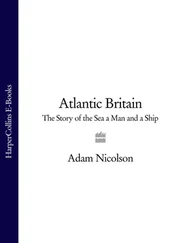Henry Field - The Story of the Atlantic Telegraph
Здесь есть возможность читать онлайн «Henry Field - The Story of the Atlantic Telegraph» — ознакомительный отрывок электронной книги совершенно бесплатно, а после прочтения отрывка купить полную версию. В некоторых случаях можно слушать аудио, скачать через торрент в формате fb2 и присутствует краткое содержание. Жанр: foreign_antique, foreign_prose, на английском языке. Описание произведения, (предисловие) а так же отзывы посетителей доступны на портале библиотеки ЛибКат.
- Название:The Story of the Atlantic Telegraph
- Автор:
- Жанр:
- Год:неизвестен
- ISBN:нет данных
- Рейтинг книги:3 / 5. Голосов: 1
-
Избранное:Добавить в избранное
- Отзывы:
-
Ваша оценка:
- 60
- 1
- 2
- 3
- 4
- 5
The Story of the Atlantic Telegraph: краткое содержание, описание и аннотация
Предлагаем к чтению аннотацию, описание, краткое содержание или предисловие (зависит от того, что написал сам автор книги «The Story of the Atlantic Telegraph»). Если вы не нашли необходимую информацию о книге — напишите в комментариях, мы постараемся отыскать её.
The Story of the Atlantic Telegraph — читать онлайн ознакомительный отрывок
Ниже представлен текст книги, разбитый по страницам. Система сохранения места последней прочитанной страницы, позволяет с удобством читать онлайн бесплатно книгу «The Story of the Atlantic Telegraph», без необходимости каждый раз заново искать на чём Вы остановились. Поставьте закладку, и сможете в любой момент перейти на страницу, на которой закончили чтение.
Интервал:
Закладка:
In happy concurrence with this, as an additional preparation, a partial survey of the Atlantic had been made the very year before this enterprise was begun, in 1853. Lieutenant Berryman was the first who applied this new method of taking deep-sea soundings to that part of the Atlantic lying between Newfoundland and Ireland, with results most surprising and satisfactory. But to remove all doubt it seemed desirable to have a fresh survey. To obtain this, Mr. Field went to Washington and applied to the Government in behalf of the Company for a second expedition.
The request was granted, and the Arctic, under command of the same gallant Lieutenant Berryman, was assigned to this service. He sailed from New York on the eighteenth of July, 1856, and the very next day Mr. Field left on the Baltic for England, to organize the Atlantic Telegraph Company. The Arctic proceeded to St. John's, and thence with a clear eye and a steady hand, this true sailor went "sounding on his dim and perilous way" across the deep. In about three weeks he made the coast of Ireland, having carried his survey along the great circle arc, which the telegraph was to follow as the nearest path from the old world to the new. The result fully confirmed his belief of the existence of a great plateau underneath the ocean, extending all the way from one hemisphere to the other.
I cannot take leave of the name of this gallant officer, who rendered such services to science and to his country, without a word of tribute to his memory. Lieutenant Berryman is in his grave. He died in the navy of his country, worn out by his devotion to her service. When the great civil war broke out, he was placed in a position most painful to a man of large heart, who loved at once his country and the state in which he was born. He was a Southerner, a native of Winchester, Va., and was assigned to duty in the South. At the first attack on Southern forts and arsenals, he was in command of the Wyandotte, in the harbor of Pensacola, in Florida. His officers, who were nearly all Southerners, were in secret sympathy with the rebellion. All the influences around him, both on ship and on shore, were such as might have seduced a weaker man from his loyalty. But, to his honor, he never hesitated for a moment. He stood firm and loyal to his flag. Not knowing whom to trust, he had to keep watch day and night against surprise and treachery. It was the testimony of Lieutenant Slemmer, then in command of Fort Pickens, that but for the ceaseless exertions of Lieutenant Berryman not only the ship but the fort would have been lost. But this service to his country cost him his life. His constant exertions brought on a brain fever, of which he died. His wife, also a native of Winchester, when the war came near her early home, removed to Baltimore, saying that "she would not live under any other flag than that under which her husband had lived and died."
It was to the honor of the American navy, to have led the way in these deep-sea soundings. But after this second voyage of exploration, Mr. Field applied to the British Admiralty, "to make what further soundings might be necessary between Ireland and Newfoundland, and to verify those made by Lieutenant Berryman." It was in response to this application that the Government sent out the following year a vessel to make still another survey of the same ocean-path. This was the steamer Cyclops, which was placed under Lieutenant Commander Joseph Dayman, of the British navy, an officer who had been with Captain Sir James Ross when he made his deep-sea soundings in the South Atlantic in 1840, where he attained a depth of twenty-six hundred and sixty-seven fathoms; and who by his intelligence and zeal, was admirably fitted for the work. To speak now of this third survey, is anticipating in time. But it will serve the purpose of unity and clearness in the narrative, to include all these deep-sea soundings in one chapter. He was directed to proceed to the harbor of Valentia in Ireland, and thence to follow, as nearly as possible, along the arc of a great circle to Newfoundland. "The soundings for the first few miles from the coast should be frequent, decreasing as you draw off shore."
These orders were thoroughly executed. Every pains was taken to make the information obtained precise and exact. Whenever a sounding was to be taken, the ship was hove to, and the bow kept as nearly as possible in the same spot, so that the line might descend perpendicularly. This was repeated every few miles until they had got far out into the Atlantic, where the general equality of the depths rendered it necessary to cast the line only every twenty or thirty miles. Thus the survey was made complete, and the results obtained were of the greatest value in determining the physical geography of the sea.
The conclusions of Commander Dayman confirmed in general those of Lieutenant Berryman, though in comparing the charts prepared by the two, we observe some differences which ought to be noticed. Both agree as to the general character of the bottom of the ocean along this latitude – that it is a vast plain, like the steppes of Siberia. Yet on the chart of Dayman the floor of the sea seems not such a dead level as on that of Berryman. (This may be partly owing to a difference of route, as Dayman passed a little to the north of the track of Berryman.) There are more unequal depths, which in the small space of a chart, appear like hills and valleys. Yet when we consider the wide distances passed over, these inequalities seem not greater than the undulations on our Western prairies. "This space," says Dayman, "has been named by Maury the telegraphic plateau, and although by multiplying the soundings upon it, we have depths ranging from fourteen hundred and fifty to twenty-four hundred fathoms, these are comparatively small inequalities in its surface, and present no new difficulty to the project of laying the cable across the ocean. Their importance vanishes when the extent of the space over which they are distributed (thirty degrees of longitude) is considered."
According to Berryman and Dayman both, the ocean in its deepest part on this plateau, measured but two thousand and three or four hundred fathoms, or about fourteen thousand feet – a depth of but little over two and a half miles. This is not great, compared with the enormous depths in other parts of the Atlantic; 8 8 "The ocean bed of the North Atlantic is a curious study; in some parts furrowed by currents, in others presenting banks, the accumulations perhaps of the débris of these ocean rivers during countless ages. To the west, the Gulf Stream pours along in a bed from one mile to a mile and a half in depth. To the east of this, and south of the Great Banks, is a basin, eight or ten degrees square, where the bottom attains a greater depression than perhaps the highest peaks of the Andes or Himalayas – six miles of line have failed to reach the bottom! Taking a profile of the Atlantic basin in our own latitude, we find a far greater depression than any mountain elevation on our own continent. Four or five Alleghanies would have to be piled on each other, and on them added Fremont's Peak, before their point would show itself above the surface. Between the Azores and the mouth of the Tagus this decreases to about three miles."
yet that it is something may be realized from the fact that if the Peak of Teneriffe were here "cast into the sea," it would sink out of sight, island, mountain and all, while even the lofty head of Mont Blanc would be lifted but a few hundred feet above the waves.
The only exception to this uniform depth, lies about two hundred miles off the coast of Ireland, where within a space of about a dozen miles, the depth sinks from five hundred and fifty to seventeen hundred and fifty fathoms! "In 14° 48' west," says Dayman, "we have five hundred and fifty fathoms rock, and in 15° 6' west we have seventeen hundred and fifty fathoms ooze. This is the greatest dip in the whole ocean."
Читать дальшеИнтервал:
Закладка:
Похожие книги на «The Story of the Atlantic Telegraph»
Представляем Вашему вниманию похожие книги на «The Story of the Atlantic Telegraph» списком для выбора. Мы отобрали схожую по названию и смыслу литературу в надежде предоставить читателям больше вариантов отыскать новые, интересные, ещё непрочитанные произведения.
Обсуждение, отзывы о книге «The Story of the Atlantic Telegraph» и просто собственные мнения читателей. Оставьте ваши комментарии, напишите, что Вы думаете о произведении, его смысле или главных героях. Укажите что конкретно понравилось, а что нет, и почему Вы так считаете.












